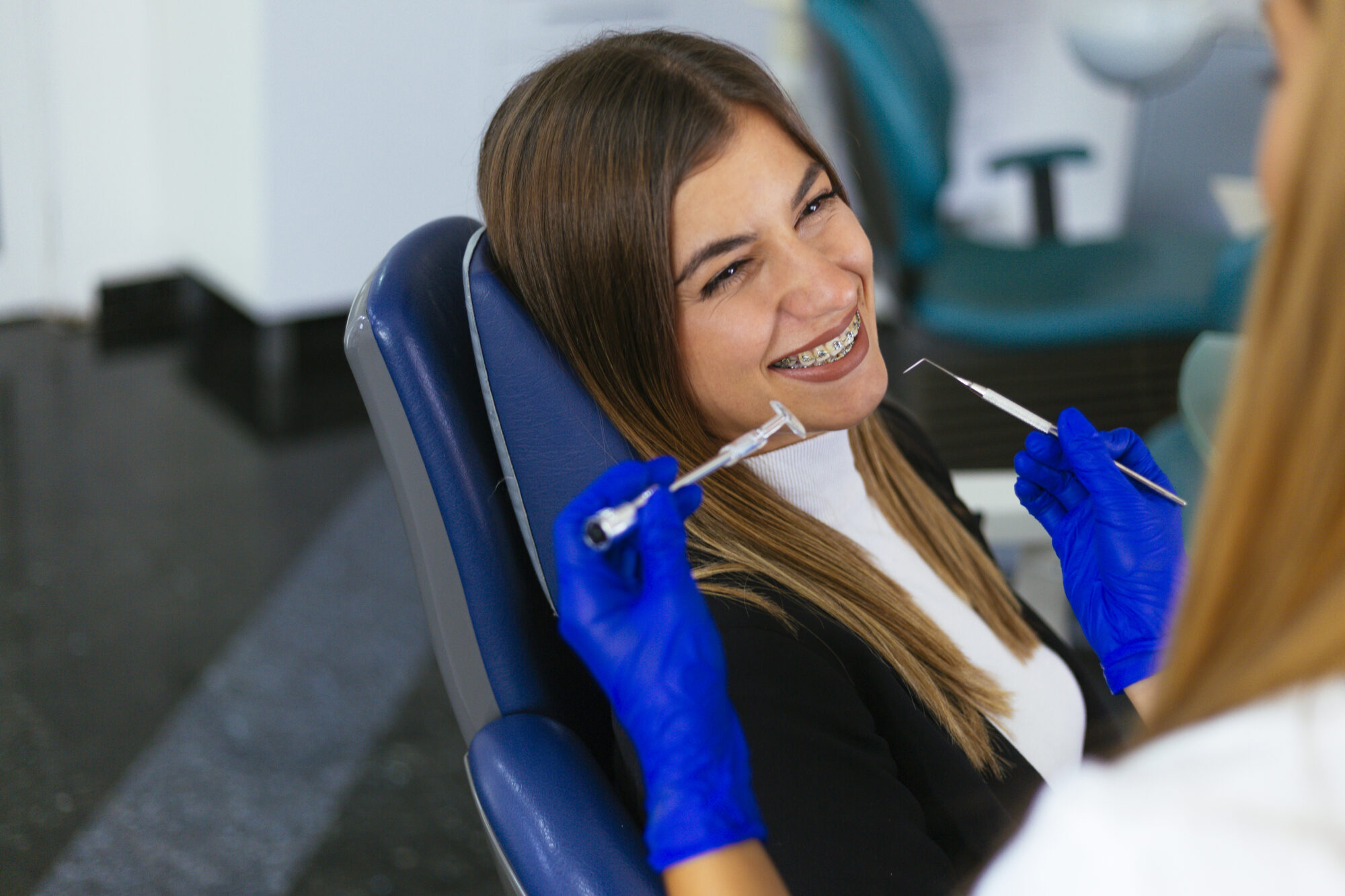Braces are a game-changer for your smile, but anyone who’s worn them knows they can come with a bit of discomfort. Whether it’s the initial soreness after getting braces or the occasional tightness after an adjustment, there are times when braces can make your mouth feel less than comfortable.
But don’t worry—brace discomfort is totally normal, and the good news is that it’s usually temporary. The pain typically fades after a few days, but until then, there are plenty of ways to manage it. In this post, we’ll share 10 tips for managing braces discomfort and help you get through your treatment with ease.
1. Use Orthodontic Wax to Protect Your Gums
One of the most common complaints from new brace-wearers is irritation from the brackets and wires. These metal parts can rub against the inside of your cheeks or gums, causing painful sores.
Solution: Orthodontic wax is your best friend in this case! It’s a soft, moldable wax that you can press over the brackets to prevent irritation. Simply break off a small piece of wax, roll it into a ball, and flatten it to cover any sharp or rough areas of your braces. This will create a barrier between your braces and the sensitive areas of your mouth.
You can remove and replace the wax as needed, especially after meals when food can get stuck. Just make sure to remove the wax before brushing and flossing to keep your teeth and braces clean.
2. Rinse with Warm Saltwater
Saltwater rinses are a simple, effective way to soothe irritated gums and help heal sores. This natural remedy helps to reduce inflammation and kill bacteria, promoting faster healing of any cuts or ulcers caused by the braces.
How to do it: Mix a teaspoon of salt in a cup of warm water and swish it around in your mouth for 30 seconds to 1 minute. Do this 2-3 times a day, especially after meals, to keep your mouth clean and reduce discomfort.
If you don’t have salt on hand, a mouth rinse with fluoride can also help, but saltwater is usually the most soothing option.
3. Take Over-the-Counter Pain Relievers
The discomfort that comes with getting braces or having them adjusted is similar to soreness from a workout—mild, but noticeable. Over-the-counter (OTC) pain relievers like ibuprofen or acetaminophen can be very helpful in easing the discomfort.
How to use: Take the recommended dosage based on the instructions on the package. Ibuprofen is particularly helpful because it’s an anti-inflammatory, which means it helps reduce both pain and swelling.
Always check with your orthodontist or dentist before taking any medication to ensure it’s safe for you, especially if you have any underlying health conditions.
4. Stick to Soft Foods During the First Few Days
When you first get your braces or after an adjustment, your teeth may feel sore or tender. Eating hard, crunchy, or sticky foods can aggravate the discomfort and even cause damage to the brackets or wires.
Tip: For the first few days, stick to soft foods like mashed potatoes, yogurt, smoothies, soups, scrambled eggs, and pasta. These foods are easy to chew and will allow your teeth to adjust without adding any extra pressure.
You can also freeze some of these foods—frozen yogurt or smoothies can feel soothing on tender teeth!
5. Use a Cold Compress to Reduce Swelling
If your cheeks or gums are swollen or painful after getting braces, a cold compress can be incredibly helpful. The cold will constrict blood vessels, reducing inflammation and numbing the area to relieve pain.
How to use: Wrap a few ice cubes in a clean cloth or use a gel ice pack, and apply it to the outside of your cheek for 10-15 minutes at a time. You can repeat this process several times throughout the day to keep swelling down and ease discomfort.
Be sure to give your skin a break between ice treatments to avoid frostbite or irritation.
6. Use an Electric Toothbrush for Gentle Cleaning
When you first get braces, brushing your teeth can feel a bit more difficult or uncomfortable due to the new hardware in your mouth. Using a regular toothbrush can sometimes cause the bristles to poke your gums, making the discomfort worse.
Solution: Consider using an electric toothbrush with a soft-bristled head. Electric toothbrushes are often more efficient at cleaning around the brackets, and the vibrations can be gentler on sore gums.
If you don’t have an electric toothbrush, make sure to brush gently with a soft-bristled manual toothbrush, paying close attention to your gums to avoid causing irritation.
7. Use a Braces-Specific Toothpaste
Some regular toothpaste can be abrasive and might irritate sensitive gums when you have braces. Instead, opt for a toothpaste specifically designed for braces. These products are typically gentler on your gums while still being effective at cleaning your teeth.
Tip: Look for toothpaste with fluoride that’s labeled for sensitive teeth or braces. This type of toothpaste will help maintain healthy teeth and gums throughout your treatment while reducing discomfort.
8. Be Mindful of Your Braces
Once your braces are on, you’ll want to be mindful of what you’re doing in your mouth to avoid aggravating any discomfort. For example, avoid playing with the wires or brackets with your fingers or tongue, as this can make the discomfort worse.
Also, be careful when using your teeth for tasks other than chewing food, like opening packages or biting your nails. Using your teeth for anything other than eating or drinking can place unnecessary pressure on your braces and cause pain or even damage.
9. Use a Warm Compress for Jaw Pain
Sometimes, the discomfort from braces can extend to your jaw. When your teeth are shifting, your jaw muscles may become sore from the extra pressure. A warm compress can help relieve tightness and reduce the discomfort in your jaw.
How to use: Soak a washcloth in warm water, wring it out, and place it against your jaw. You can also use a heating pad on a low setting. Apply it for 10-15 minutes at a time, and repeat as necessary.
A warm compress is especially helpful for those who experience pain in the jaw from an overbite or underbite during treatment.
10. Stay Consistent with Your Checkups
Finally, remember that regular visits to your orthodontist are key to managing discomfort and ensuring your treatment is progressing as planned. Your orthodontist can make adjustments as needed to minimize discomfort and ensure that everything is fitting properly.
During your checkups, your orthodontist will monitor your progress, make necessary adjustments to the brackets and wires, and give you tips for making your treatment more comfortable. Consistency with your checkups will help you stay on track for achieving the best results in the least amount of time.

Braces Discomfort Doesn’t Last Forever
While braces may cause some discomfort during your treatment, it’s important to remember that the pain is usually temporary and part of the process. Following these 10 tips for managingbraces discomfort can help make the journey more comfortable and smoother.
From using orthodontic wax to taking OTC pain relievers and sticking to soft foods, there are plenty of ways to minimize discomfort and stay on track with your treatment. And remember—once your braces come off, the results will be worth every moment of discomfort!
If you have any concerns about your braces or pain that isn’t improving, don’t hesitate to reach out to the Noble Orthodontics team. We are here to ensure your treatment is as comfortable and effective as possible.
 919-338-5650Free Consult
919-338-5650Free Consult


